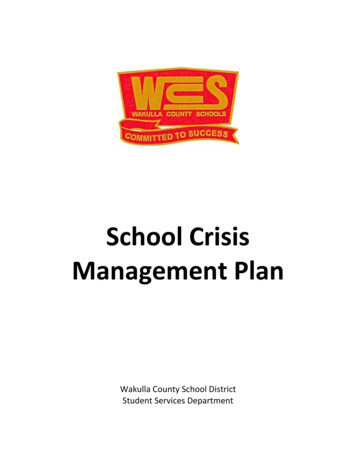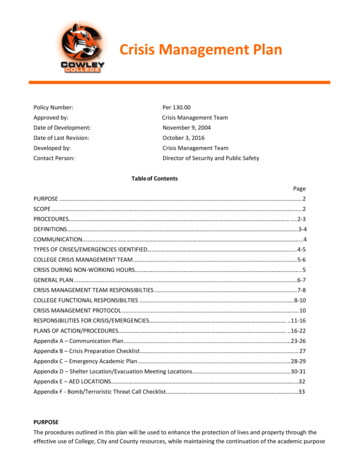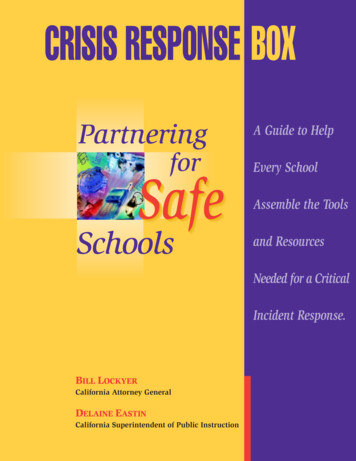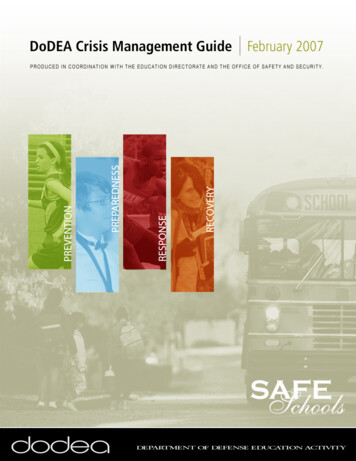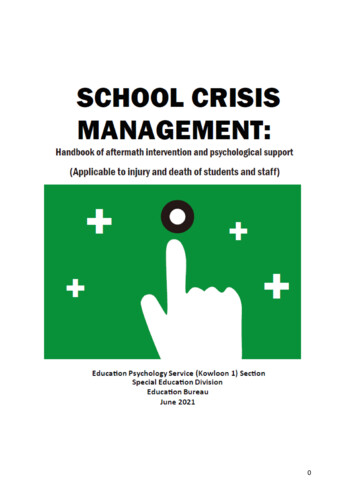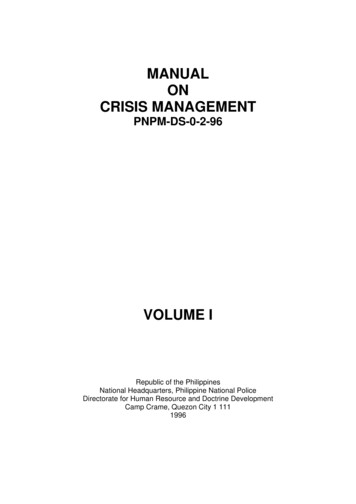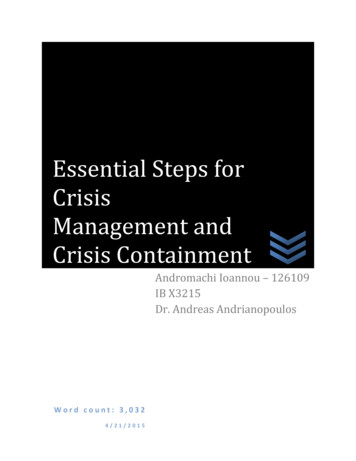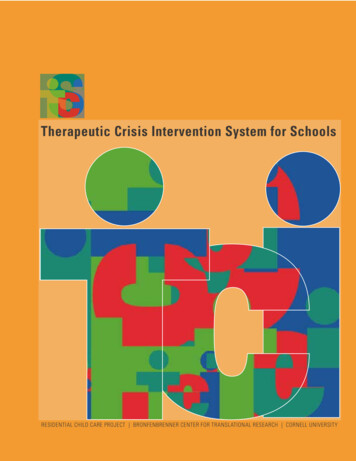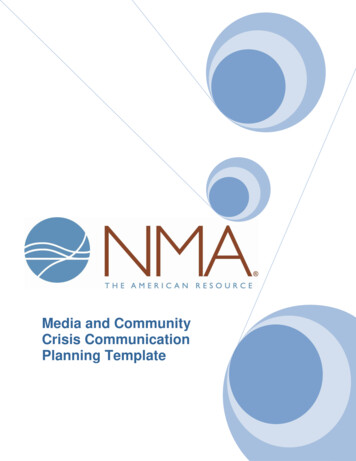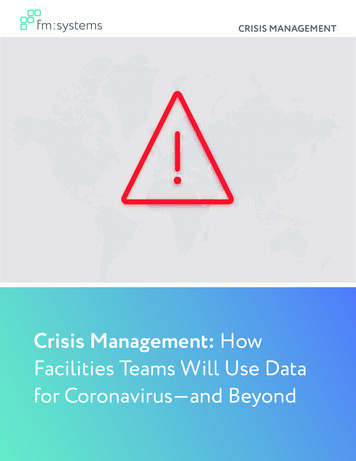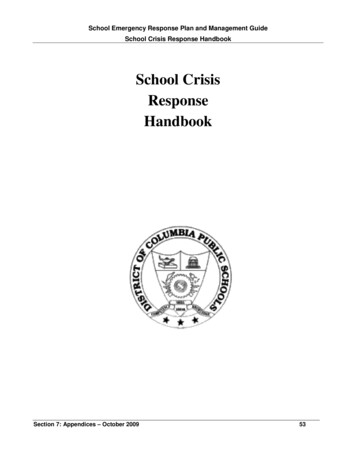
Transcription
School Emergency Response Plan and Management GuideSchool Crisis Response HandbookSchool CrisisResponseHandbookSection 7: Appendices – October 200953
School Emergency Response Plan and Management GuideSchool Crisis Response HandbookSection 7: Appendices – October 200954
School Emergency Response Plan and Management GuideSchool Crisis Response HandbookSCHOOL CRISIS RESPONSEHANDBOOK2007-2008Revised 12/4/07Section 7: Appendices – October 200955
School Emergency Response Plan and Management GuideSchool Crisis Response HandbookTable of ContentsSchool Crisis Response HandbookIntroduction. 57DCPS Crisis Responses Protocol. 58Glossary of Terms. 59Pre-Crisis Planning . 60Roles and Responsibilities During a Crisis . 61Crisis Response Forms . 63Phone-Critical Incident Response Request: Based Needs Assessment. 64Needs Assessment Planning/Intervention Recommendations. 66Persons Directly Impacted . 67Daily Intervention Sheet . 69Central Crisis Team Sign-In Sheet . 71Crisis Response Student Sign-In Sheet . 72Crisis Response Staff Sign-In Sheet . 73Crisis Response Follow-up Student Identification Sheet . 74Critical Incident After-Report . 75Summary of Interventions . 76Crisis Team Debriefing . 78Community Resources. 79School Resource Sheets to Assist in Responding to a Crisis . 80General Reactions to Death . 80Student Reactions to Suicide . 82Guidelines for Making a Referral . 83Sample Script for Faculty Information Meeting . 84Sample Letter to Parents . 85Strategies for School Staff When Dealing With a Crisis . 86Instructions for Teachers . 87Guidelines for a Classroom Presentation . 88Memorial Guidelines . 90Section 7: Appendices – October 200956
School Emergency Response Plan and Management GuideSchool Crisis Response HandbookSCHOOL CRISIS RESPONSEHANDBOOKIntroductionThe primary purpose of this DCPS Crisis Response Handbook is to assist school staff andadministration in managing school crises in a universal, consistent, and appropriate manner. Thismanual is intended to create and foster a proactive approach to potential crises in schools. It preparesthe total school community to cope with the possible impact of a destabilizing occurrence. What makesthis manual especially valuable is that it can be applied and adapted to the particular culture andorganizational structure of each school.This handbook includes suggested procedures and resources to guide the School Crisis Team. Allresponses to crisis situations promote the school system's goal of a safe and orderly learningenvironment by reducing the impact of grief and loss that interferes with the normal school functioningand the learning process.Materials compiled in this handbook were adapted from resources used in Howard County PublicSchools, Montgomery County Public Schools, Fairfax County Public Schools, DC Department ofMental Health – School Mental Health Program, as well as past DC Public Schools Crisis ResponseHandbooks.What Is a Crisis?A crisis is defined as a death or other traumatic event involving a student or staff member due to anaccident, community violence, suicide, homicide, illness, natural disaster, or terrorism that interruptsthe normal day-to-day functioning of the school.Who Is Responsible for Responding to a Crisis?Each school has a School Crisis Team comprised of the principal, assistant principal(s), schoolcounselor(s), health assistant and/or nurse, school psychologist, and social worker. One of these teammembers should be identified as the School Crisis Team chairperson. School-based teams provideprevention information, intervention, and support to school staff, students, and parents during and inthe aftermath of a crisis or traumatic event. This team is also responsible for deciding if additionalsupport is needed from the Central Crisis Team.When Is the Central Crisis Team contacted?The decision to contact the Central Crisis Team is made by the principal, in consultation with thecoordinator of the School Crisis Team and the Supervisor of Social Workers. If it is determined thatadditional support is necessary, the Supervisor of Social Workers contacts the appropriate teammembers. The role of the Central Crisis Team is to provide consultation and support to the Schoolbased Team. The Central Crisis Team is comprised of social workers and psychologists from DCPSand DMH who have advanced training and expertise in the area of crisis management. The Supervisorof Social Workers remains available for consultation.Section 7: Appendices – October 200957
School Emergency Response Plan and Management GuideSchool Crisis Response HandbookDCPS CRISISRESPONSE PROTOCOL The school principal will identify all school-based team members who will be responsible forcoordinating the school's crisis response and post names around the school. The principal willeither serve as chair of this School Crisis Team or designate a team member to serve as thechairperson.The principal/designee will assess impact of crisis on the school community that may affectstudents, staff, parents and local community members.The principal/designee contacts the following to inform of crisis event and give assessmentinformation: Office of Assistant Superintendents (202–442–5055); Division of School Security (202–576–6962); and Supervisor of Social Workers/Central Crisis Team Coordinator (202–442–5138 or 202–442–4800). The Supervisor of Social Workers/Central Crisis Team Coordinator will assess the CrisisResponse Level of Need and deploy Central Crisis Team members to school.The Supervisor of Social Workers/Central Crisis Team Coordinator (202–442–5138 or 202–442–4800) will also assign one deployed Central Crisis Team member as Team Leader.Central Crisis Team members will reassess the situation with the School Crisis Team andprincipal.Central Crisis Team members will coordinate onsite intervention with School Crisis Teammembers with input from the principal/designee.If deemed necessary, Central Crisis Team members will bring other trained and certified mentalhealth personnel to create and implement a plan of action.Principal, School Crisis Team, and Central Crisis Team members will provide up-to-dateinformation to staff regarding the crisis, plan of action, and any other relevant information.Students will be provided debriefing, counseling, and/or support according to the plan ofaction.Staff members will be provided debriefing, counseling, and/or support according to the plan ofaction.Appropriate correspondence will be sent to parents and community.Followup services for students will be planned and scheduled.Crisis team is debriefed.Documentation of incident will be completed.Section 7: Appendices – October 200958
School Emergency Response Plan and Management GuideSchool Crisis Response HandbookDCPS CRISIS RESPONSEPROTOCOLGlossary of TermsCrisis—an event that produces a temporary state of psychological disequilibrium and a subsequentstate of emotional turmoil that disrupts the educational program.School Crisis Team—may consist of administrative team members, on-site social worker, schoolcounselor, school psychologist, nurse, health/physical education teacher, peer mediationcoordinator, and an on-site community mental health provider if there.Crisis Response Level of Need— Level 1—School-based response to a crisis event—School Crisis Team (SCT) responds. Forexample, a current or former staff member dies after a long illness.Level 2—Central Crisis Team response to a crisis event—SCT and Central Crisis Team (CCT)both respond. For example, unexpected death of a current student or staff member on or offcampus.Level 3—DCPS/DMH team response to a major emergency or community crisis event—SCT,CCT, and DMH respond. For example, shooting at the school, community disaster such as amajor fire, natural disaster or terrorism.Central Crisis Team—consists of trained DCPS social workers and psychologists as well as schoolmental health providers from the Department of Mental Health.Section 7: Appendices – October 200959
School Emergency Response Plan and Management GuideSchool Crisis Response HandbookPre-Crisis PlanningThe school principal will identify all school-based team members responsible for coordinating theschool’s crisis response and post names around the school. The principal will either serve as chair ofthis School Crisis Team or designate a chairperson. The principal will meet with the Team to discusstheir roles and responsibilities and to review the pre-crisis planning process.Prepare Telephone Tree Administrator; School psychologist; School counselor; Social worker; Health assistant/nurse; and Other staff.Assemble Crisis Intervention Packets and Related Materials Determine the materials needed including maps of the school building, lists of teachers/roomassignments, copies of bell schedule, including lunch and recess times, name tags, tissues,crayons, markers, construction paper, and copies of yearbooks or memory books. Determine where these materials will be stored, such as, front and/or guidance office. List of School Crisis Team Members.Determine Where Crisis Intervention Support Will Occur Determine where crisis team members will meet with students/staff individually or in groups. Determine the sign-in procedures for visitors. Determine where parents will meet if they arrive at the school. Determine where crisis team members will meet to plan and have access to telephoneSection 7: Appendices – October 200960
School Emergency Response Plan and Management GuideSchool Crisis Response HandbookRoles and ResponsibilitiesDuring a CrisisA number of roles should be performed by key personnel. This list represents, at a minimum, whatresponsibilities key personnel have in responding to a crisis.Administrator only— Verify facts of the crisis incident.Authorize intervention efforts.Consult with school security to assure the safety of the students, staff, and community.Notify appropriate central office personnel of crisis incident and other affected schools.Notify school-based administrators and school-based student services personnel of crisisincident.Initiate phone tree for school-based personnel.Be highly visible, show presence, support and control of crisis.Facilitate before-school faculty information meeting.Keep all teachers and other school-based personnel updated on facts, events, circumstances,funeral arrangements, etc.Inform parents of facts, events, circumstances, funeral arrangements, etc.Provide direction about rescheduling activities.Reschedule activities, appointments, and meetings not of an emergency nature.Consult with public information officer regarding release of information to media and public.School Crisis Team Chairperson and/or Administrator: Help coordinate intervention efforts with principal approval.Verify facts of crisis incident.Meet to assess the degree of impact and extent of support needed.Assemble School Crisis Team, and, if necessary, the Central Crisis Team.Establish preplanning meeting time for crisis team members as appropriate.Develop statement to share with teachers and other school–based personnel.Develop statement to share with students.Identify at-risk staff.Provide follow-up as needed for staff and students and monitor behavior.Central Crisis Team Leader— Assist in planning, coordinating, and provisioning for school-based crisis response.Complete all paperwork in timely fashion.Send paperwork to Supervisor of DCPS social workers and Program Director of School-basedMental Health of the Department of Mental Health.Central Crisis Team— Be available during school hours to school-based and central office-based administrators andstudent services personnel for consultation in the event of a school crisis.Section 7: Appendices – October 200961
School Emergency Response Plan and Management GuideSchool Crisis Response Handbook Share responsibility outside of school hours for consulting with school-based and centraloffice-based administrators and student services personnel in the event of a school crisis.Assist in the coordination, planning, and provision of school crisis responses by the CentralCrisis Team.School-based counselor and/or school social worker— Support intervention efforts.Reschedule activities, appointments, and meetings not of an emergency nature.Provide individual and group counseling.Maintain a list of students seen by support staff. Make follow-up calls to families of studentsin distress and recommendations for the family to provide support and/or follow-up.Monitor and provide follow-up services to affected students.Be available to staff and provide support, as needed.Faculty— Provide accurate, factual information to students.Identify students who need support and refer them to school-based support personnel.Facilitate classroom discussions that focus on helping students to cope with the crisis; ifappropriate, provide activities such as artwork or writing to help students cope.Dispel rumors.Answer questions without providing unnecessary details.Model an appropriate grief response and give permission for a range of emotions.Structure classroom activities, postpone and reschedule tests, quizzes, and assignments, asappropriate.Nurse/Physical Education Leader in absence of nurse— Administer first aid.Request that paramedics and an ambulance be called, as necessary.Appoint someone to meet paramedics at the designated entrance (s) and give directions to thelocation of the injured.Arrange for someone to travel with students to the hospital, as appropriate.Call for additional school nursing assistance, as needed.Ask for coverage by a principal's designee if the nurse is needed elsewhere.Refer distressed students and faculty to school-based support personnel.Secretary— Provide accurate, factual information via written statement to inquiring parents andcommunity members.Supervise visitor sign-in procedures.Direct central office and Central Crisis Team members to appropriate locations.Refer distressed students and faculty to school-based support personnel.Provide secretarial support to school-based and Central Crisis Team members, such ascopying, as needed.Section 7: Appendices – October 200962
School Emergency Response Plan and Management GuideSchool Crisis Response HandbookDISTRICT OF COLUMBIA PUBLIC SCHOOLSDepartment of Mental HealthCRISIS RESPONSE FORMSFor Level 2 and Level 3 CrisesDCPS Crisis Response Model: Level of CrisisLevel 1School Based response to a crisis event—SCT responds. For example, a current or former staffmember dies after a long illness.Level 2Central Crisis Team response to a crisis event—SCT and CCT both respond. For example, theunexpected death of a current student or staff member on or off campus.Level 3DCPS/DMH Team response to a major emergency or community crisis event—SCT, CCT, and DMHrespond. For example, a shooting at the school, community disaster such as a major fire, naturaldisaster, or terrorism.Section 7: Appendices – October 200963
School Emergency Response Plan and Management GuideSchool Crisis Response HandbookPHONE-CRITICAL INCIDENTRESPONSE REQUEST:BASED NEEDS ASSESSMENTThe person first informed of the school crisis should complete this form. In most cases, this willbe the Supervisor of Social Workers.Person Taking Call: Date: Time of Call:Name of Person Calling: Phone Number:Name of Onsite Contact: Phone Number:Address of Response Site:1. What happened/what was the crisis event?2. When did it occur?Date:Time of day3. Where did the crisis/event occur?4. Who was directly involved or affected (person witnessed event, was a close familymember/friend, a victim, etc.)? Please specify how the individuals were involved or affected andhow many people/classrooms are affected.Age groups:Primary language:5. Who was indirectly involved or affected (community, neighborhood, school, classmates, etc.):Please specify how the individuals were involved or affected and how many people/classroomsare affected.Age groups:Primary language:6. Do you have an internal crisis management team and/or counselors?YESNOWhat actions/interventions have been completed (has information been provided tostudents/staff, have any groups been held, etc.)? (If applicable, please provide copy(ies) ofinformation available if/when team arrives):Section 7: Appendices – October 200964
School Emergency Response Plan and Management GuideSchool Crisis Response HandbookResults:7. What other agencies/offices are involved or have been contacted (police, fire department, DOH,DCPS, CACRT, DMH, etc.)?Contact person/number for the agency:Services/interventions/support they are providing:Results:8. Has any information about the crisis been disseminated to the various populations affected by thecrisis (letter sent home to parents, town meeting, media, etc.)? Please have a copy(ies) availableif/when team arrives.9. What type(s) of support or services are you requesting?Providing s counseling/stabilizationBilingual counselor/translatorDon’t know/unsureOther10. Is there any other information that you would like to add that might be helpful to our responseteam?For Internal Purposes OnlyDoes this call require an immediate deployment of staff?YesNoWhat other agencies/offices need to be contacted?NOTE: Fax this form to CENTRAL CRISIS TEAM leader. If incomplete, leader needs tocomplete form once at the school.Fax number:Section 7: Appendices – October 200965
School Emergency Response Plan and Management GuideSchool Crisis Response HandbookNeeds Assessment Planning/Intervention RecommendationsStudentsSchool StaffClassroom Presentation:Fan Out/Faculty Information MeetingTopic/Focus:# Clinicians needed# Classrooms# Clinicians needed# Clinicians neededList grade levels:Small Support Group# Groups (support)# Clinicians neededList grade levels:Operational DebriefingSmall Support Group# Groups (support)# Clinicians neededIndividual Session# Staff# Clinicians neededIndividual Session# Students# Clinicians neededCommunityParents/FamiliesTown Hall MeetingLetters Sent HomeTopic/Focus:Small Support Group# People attending#Clinicians needed# Clinicians needed#Parents/adult family membersIndividual Session# Adults# Clinicians neededSection 7: Appendices – October 200966
School Emergency Response Plan and Management GuideSchool Crisis Response HandbookPersons Directly Impacted(victim, witnessed event, close friend, family member of victim)StudentsSchool StaffSmall Support Group/Defusing (grades Pre-K-5)Debriefing# Groups (defusing)# Teachers# Groups (support)# Administrators# Clinicians needed# Support StaffList grade levels:# Clinicians neededSmall Support Group/Debriefing (grades 6-12)# Staff# Groups (debriefing)# Clinicians neededIndividual Session# Groups (support)# Clinicians neededList grade levels:Individual Session# Students# Clinicians g#Parents/adults# People involved#Clinicians needed# Clinicians neededIndividual Session# Adults# Clinicians neededComments:.Section 7: Appendices – October 200967
School Emergency Response Plan and Management GuideSchool Crisis Response HandbookSection 7: Appendices – October 200968
School Emergency Response Plan and Management GuideSchool Crisis Response HandbookDAILY INTERVENTION SHEETIntervention Site (include address/phone)Circle one: Day one Day twoDay threeDay fourAdditional DaysSTUDENTS# Implemented# Not implemented*Classroom Presentation(s)Small Support GroupDebriefing/DefusingIndividual SessionsTOTAL # students seenSTAFF# Implemented# Not implemented*Operational DebriefingSmall Support GroupSmall Group DebriefingIndividual SessionsTOTAL No. staff seenPARENTS/FAMILY# Implemented# Not implemented*Letter sent homeDebriefingIndividual SessionsTOTAL No. parents/family members seenCOMMUNITY# Implemented# Not implemented*Town hall meetingDebriefingTOTAL No. community members seenWhich interventions were recommended but NOT implemented, and why?Section 7: Appendices – October 200969
School Emergency Response Plan and Management GuideSchool Crisis Response HandbookPlease describe what was effective:Please describe what was challenging and issues that were raised:Section 7: Appendices – October 200970
School Emergency Response Plan and Management GuideSchool Crisis Response HandbookCentral Crisis TeamSign-In SheetNameSection 7: Appendices – October 2009NumberSign In/Sign OutPosition71School Phone
School Emergency Response Plan and Management GuideSchool Crisis Response HandbookCrisis Response Student Sign-In SheetSchoolName of Student SeenDateTeacher’s Name/GradeServices es NoYes NoYes NoYes NoYes NoYes NoYes NoYes NoYes NoYes NoYes NoYes NoSection 7: Appendices – October 200972
School Emergency Response Plan and Management GuideSchool Crisis Response HandbookCrisis Response Staff Sign-In SheetSTAFF NameGrade LevelPositionFollow-upNeeded?Yes NoYes NoYes NoYes NoCopies: Coordinators, School Counselor.Section 7: Appendices – October 200973
School Emergency Response Plan and Management GuideSchool Crisis Response HandbookCrisis Response Followup Student Identification SheetSchoolName ofStudent/TeacherDateReason for ReferralSection 7: Appendices – October 2009Who SawThem?Type of Follow-upNeeded74
School Emergency Response Plan and Management GuideSchool Crisis Response HandbookCRITICAL INCIDENT AFTER-REPORTComplete this form following implementation of services by the Crisis Team Leader and Supervisor ofSocial Workers who gathered information and coordinated the interventions.E-mail completed form to Supervisor of Social Workers at sandy.spears@k12.dc.usName of Person(s) Completing Form: Date of Report:Intervention Site (include address):Date(s) of Intervention(s): Central Crisis Team Leaders(s) if appropriate:School Contact Person:Brief Description of Critical Incident:Names of Clinicians Involved:Total # HrsRole of Clinicians:List action(s)/interventions the site/school implemented prior to CRISIS TEAM response:List other agencies involved/present:Describe services other agencies provided:Section 7: Appendices – October 200975
School Emergency Response Plan and Management GuideSchool Crisis Response HandbookSUMMARY OF INTERVENTIONSSTUDENTS# Implemented# Not implemented*Classroom Presentation(s)Small Support GroupDebriefing/DefusingIndividual SessionsTOTAL No. studentsSTAFF# Implemented# Not implemented*Operational DebriefingSmall Support GroupSmall Group DebriefingIndividual SessionsTOTAL No. staffPARENTS/FAMILY# Implemented# Not implemented*Letter sent homeDebriefingIndividual SessionsTOTAL No. parents/familyCOMMUNITY# Implemented# Not implemented*Town hall meetingDebriefingTOTAL No. communityWhich interventions were recommended but NOT implemented, and why?Section 7: Appendices – October 200976
School Emergency Response Plan and Management GuideSchool Crisis Response HandbookPlease describe what was effective:Please describe what was challenging and issues that were raised:Follow-up Recommendations Provided to Response SiteMonitor high-risk students/exposed persons (NOTE: Determine who will followup with the highrisk and/or absent students and staff).Distribute provided information as necessary (e.g., normal reactions to grief).Link with community resources/refer for additional mental health services (See list of CoreService Agencies).Perhaps contact the Wendt Center for Loss and Healing.Contact DMH/ACCESS HELPLINE for additional services.OtherSection 7: Appendices – October 200977
School Emergency Response Plan and Management GuideSchool Crisis Response HandbookCRISIS TEAM DEBRIEFINGDebriefing should occur at the end of each day in which staff is working at a critical incident site.Please include members of School Crisis Team if they are assisting with the crisis response.Person Leading the Debriefing:Date of Debriefing:Staff Present at Each DebriefingPlease address these points at the debriefing: Check-in;Emotional reactions;Reassess needs of school/clinicians;If necessary, plan for next day/days; andIf necessary, communicate with coordinator/clinicians for next day.Comments:Section 7: Appendices – October 200978
School Emergency Response Plan and Management GuideSchool Crisis Response HandbookCOMMUNITY RESOURCESDC Mental Health Access Help Line:1-888-793-4357Children’s National Medical Center:111 Michigan Ave., N.WWashington, D.C 20010Referral and Information Service1–888–884–BEAR (2327)Hospice Care of D.C.:4401 Connecticut Avenue, NWSuite 700Washington, D.C. 20008202– 244–8300 OfficeWendt Center for Loss and Healing:730 11th Street NW, Third FloorWashington, DC 20001-4510202–624–0010Section 7: Appendices – October 200979
School Emergency Response Plan and Management GuideSchool Crisis Response HandbookGENERAL REACTIONS TO DEATHSchool Resource Sheet to Assist in Responding to a CrisisFor all ages: Avoid jargon, clichés, technical terms, or euphemisms when working with students (e.g., Tears won’t help, or He or she would havewanted you to , or It’s nature’s way.)Be direct and use statements such as died rather than passed on, etc.Developmental Ages and Possible Reactions to DeathAgeThey Think: 3–5 years(preschool) 6–9 years Death is temporary andreversibleFinality of death is notevidentDeath means deceasedtaking a trip, sleepingOr wonder what deceasedis doingAbout the finality of deathAbout the biologicalprocesses of deathDeath is related tomutilationA spirit gets you whenyou dieAbout who will care forthem if a parent diesTheir actions and wordscaused the deathSection 7: Appendices – October 2009They Feel: SadAnxiousWithdrawnConfused about changesAngryScaredCranky (feelings areacted out in play)SadAnxiousWithdrawnConfused about thechangesAngryScaredCranky (feelings actedout in play)They Do: Interventions:CryFightShow interest indead thingsAct as if death neverhappened. Provide them with words for some of theirfeelings: grief, sadness, numbness.Answer correctly and lovingly. Be honest. Don’ttell half-truths.Short-term regressive behaviors are normal.Say to children, “Let’s see what we can do to makethis less scary for you.”Behave aggressively Children need permission to concentrate onmourning before they can be expected to moveAppear withdrawnforward.Experience Offer constructive ways to express their feelings.nightmaresAct as if death never Support groups can be very helpful.happenedLack concentrationHave a decline ingrades80
School Emergency Response Plan and Management GuideSchool Crisis Response HandbookDevelopmental Ages and Possible Reactions to Death (continued)AgeThey Think: 9–12 years 12–UpAdolescents They Feel:They Do:About and understandthe finality of deathDeath is hard to talkaboutThat death mayhappen againAbout what willhappen if theirparent(s) dieTheir actions andwords caused death onedGuiltyFearfulWorriedIsolated About and understandthe finality of deathIf they show theirfeelings, they will beweakTh
Dec 04, 2007 · Central Crisis Team members will coordinate onsite intervention with School Crisis Team members with input from the principal/designee. If deemed necessary, Central Crisis Team members will bring other trained and certified mental h
